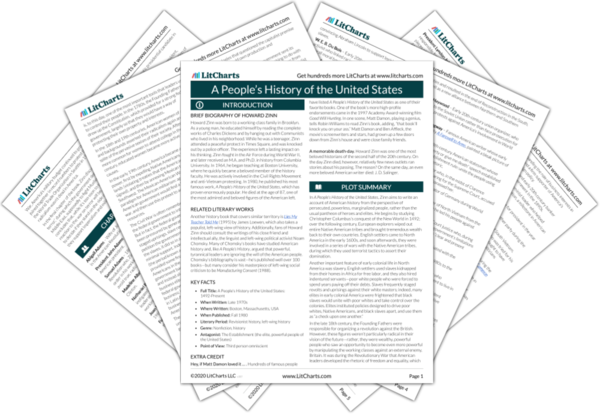The economic system in which private owners control the “means of production” (industry, manufacturing, and trade). Since the 1500s, most Western economies have been predominately capitalist, while incorporating elements of Socialism. In the 19th century, capitalist systems of production incentivized the Industrial Revolution and the growth of science and technology, allowing some wealthy industrialists to become astonishingly rich. However, capitalism has been criticized for exploiting working-class people and creating a way of life that is petty, materialistic, and ultimately meaningless.
Capitalism Quotes in A People’s History of the United States
The A People’s History of the United States quotes below are all either spoken by Capitalism or refer to Capitalism. For each quote, you can also see the other terms and themes related to it (each theme is indicated by its own dot and icon, like this one:
).
Chapter 23
Quotes
The great problem would be to work out a way of accomplishing this without a centralized bureaucracy, using not the incentives of prison and punishment, but those incentives of cooperation which spring from natural human desires, which in the past have been used by the state in times of war, but also by social movements that gave hints of how people might behave in different conditions. Decisions would be made by small groups of people in their workplaces, their neighborhoods—a network of cooperatives, in communication with one another, a neighborly socialism avoiding the class hierarchies of capitalism and the harsh dictatorships that have taken the name "socialist."
Page Number and Citation:
Explanation and Analysis:
Get the entire A People’s History LitChart as a printable PDF.

Capitalism Term Timeline in A People’s History of the United States
The timeline below shows where the term Capitalism appears in A People’s History of the United States. The colored dots and icons indicate which themes are associated with that appearance.
Chapter 9: Slavery Without Submission, Emancipation Without Freedom
...that the “betrayal of the Negro” was indicative of something even more horrible: “a new capitalism and a new enslavement of power.” After the 1870s, he argued, American capitalists became more...
(full context)
Chapter 11: Robber Barons and Rebels
...of the 19th century was biased against farmers’ interests and toward the interests of urban capitalists. In the western U.S., farmers had to purchase machinery from industrialists and merchants, and, if...
(full context)
...party. The party’s platform was simple: the U.S. had come under the control of urban capitalists who didn’t have the people’s interests in mind. In many ways, Zinn acknowledges, the Populist...
(full context)
Chapter 12: The Empire and the People
...black revolutionaries, and partly for economic reasons, since independent Cuba would be no friendlier to capitalism than a Spanish-Cuban colony.
(full context)
Chapter 13: The Socialist Challenge
...other side of the political spectrum, the early 20th century saw the continued dominance of capitalist leaders like J. P. Morgan. But even Morgan wasn’t immune from financial recessions. Partly in...
(full context)
...At the meeting, the I.W.W. expressed the need for equality, inclusion, and “direct action” against capitalism. Zinn argues that elites, recognizing that the I.W.W. was dangerous to their interests, attacked the...
(full context)
...startling rate. An increasing number of moderate and middle-class people were embracing the idea that capitalists exerted too much power over the country. Around this time, Eugene Debs emerged as a...
(full context)
Chapter 14: War is the Health of the State
...since the conflict in Europe was threatening its foreign markets. Between 1914 and 1917, American capitalists traded with England, to the point where England became “a market for American goods and...
(full context)
Chapter 15: Self-help in Hard Times
...I.W.W., and it was a peaceful form of resistance to what the workers saw as capitalist exploitation. However, in response to the strike, the federal government sent troops and the strike...
(full context)
...economic misinformation, and, not least, the “bad distribution of income.” In 1929, one could argue, capitalism proved to be “a sick and undependable system.”
(full context)
...classes: most of all, “internal control by their own organizations.” When the New Deal concluded, “capitalism remained intact,” and many of the same wealthy people continued to control the country.
(full context)
Chapter 16: A People’s War?
...unique in American history because it was widely regarded as the “people’s war”—a fight that capitalist, Communist, working-class and upper-class Americans supported. World War Two was a fight against evil: the...
(full context)
...and its own people. Only a few years after the Great Depression, war had rejuvenated capitalism and strengthened the elite. Workers and farmers benefitted from war in more modest ways. However,...
(full context)
Chapter 17: “Or Does It Explode?”
...blacks into the Establishment. Banks and firms invested a lot of money in developing “black capitalism,” and during the seventies more black faces appeared on television and film, “creating an impression...
(full context)
Chapter 18: The Impossible Victory: Vietnam
...natural resources as reasons for ensuring that Vietnam remain under the control of a Western, capitalist power. The American government, cooperating with the existing French leadership, installed an official named Ngo...
(full context)
Chapter 19: Surprises
...the “antagonist” against which working-class feminists protested was not just “aggressive male domination,” but also “capitalism.”
(full context)
Chapter 21: Carter-Reagan-Bush: The Bipartisan Consensus
...had strong corporate connections. Carter conducted a foreign policy that mixed human rights protections with capitalist self-interest. For example, he spoke out against apartheid (racial segregation and discrimination) in South Africa,...
(full context)














